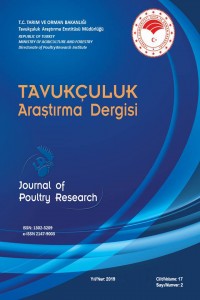Kahverengi Yumurta Üretiminde Kullanılan Saf Hatların Büyütme Dönem Sonu Canlı Ağırlıklarının Yumurta Performansına Etkileri
Abstract
Bu çalışma, kahverengi yumurta üretiminde kullanılmak üzere geliştirilen ATAK-S tavukların ebeveynleri olan RIR-I ve BAR-I saf hatlarında büyüme dönem sonu canlı ağırlığının yumurtlama dönemindeki verim özelliklerine etkilerini ortaya koymak amacıyla yürütülmüştür. BAR-I ve
RIR-I genotiplerinin 16 haftalık yaşta, %50 verim yaşında, 40 haftalık yaştaki canlı ağırlık kazançları ve 16-40 haftalık yaş aralığındaki ölüm oranları bakımından genotipler arasında istatistik bakımından önemli farklılıklar olduğu saptanmıştır. İlk yumurtlama yaşı, %50 verim yaşı ve pik verim yaşına BAR-I genotipi ağır grupta olanlar daha erken ulaşmıştır. RIR-I genotipi hafif grupta olanlar bu verim seviyelerine en geç ulaşmıştır. BAR-I genotipinin yumurta verim tavuk/gün (adet) ve tavuk/kümes (adet) değerleri bakımından RIR-I genotipinden fazla olduğu ancak kuluçkalık yumurta verim (adet) bakımından RIR-I genotipinin daha fazla verim değerine ulaştığı ortaya çıkmıştır. Yumurta iç ve dış kalite özellikleri bakımından genel olarak hatlar arasındaki farklılık önemli bulunmuştur. Tüy skorları genotipler arasında farklılıklar önemli bulunmuş ve yaşa bağlı olarak tüy skorunun düştüğü gözlemlenmiştir. FPD değerlerinde ise genotipler arasında farklılıklar önemli olmadığı, ancak yaş ve canlı ağırlık arttıkça FPD zararlarının arttığı görülmüştür. Araştırma sonucunda, RIR-I ve BAR-I saf hatlarında büyütme dönemi sonu canlı ağırlıklara göre sınıflandırmanın özellikle kuluçkalık yumurta üretimi açısından yararlı olabileceği ortaya çıkmıştır
References
- Doğan, D. 2015. Ankara Tavukçuluk Araştırma Enstitüsündeki kahverengi yumurtacı ebeveyn hatların bazı verim özelliklerinin belirlenmesi, Doktora Tezi, Akdeniz Üniversitesi Fen Bilimleri Enstitüsü Zootekni Anabilim Dalı, s, 92, Antalya.
- Dunnington, E. A., Siegel, P. B. 1996. Long-term divergent selection for eight-week body weight in White Plymouth Rock chickens, Poultry science, 75(10), 1168-1179.
- Durmuş, İ., Türkoğlu, M. 2007. Geliştirilmekte olan yerli beyaz yumurtacı saf hatlar ve melezlerinde bazı verim ve yumurta kalitesi özellikleri, Tavukçuluk Araştırma Dergisi,7(1), 23-30.
- Durmuş, İ., Sarıca, M., Aktan, S., Yıldız, T., Kahraman, Z., Ertaş, S. 2009. The Determining Performance of Commercial Native Laying Hybrids, Tavukçuluk Araştırma Dergisi,8(1), 5-9.
- Durmuş, İ., Kamanlı, S., Demirtaş, Ş. E., Demir, S. 2010. Barred Rock-1, Rhode Island Red-2 ve Colombian Yumurtacı Saf Hatlarında Yumurta Kalite Özellikleri, Lalahan Hayvancılık Araştırma Enstitüsü Dergisi, 50(1), 33-39.
The Effects of End of the Growth Period Live Weights on Pure Lines Egg Yield Used in Brown Egg Production
Abstract
This study was carried out in order to reveal the effects of live weight at the end of the rearing period on yield characteristics during the laying period in RIR-I and BAR-I pure lines, which are the parents of ATAK-S chickens developed for use in brown egg production. Significant differences were found between genotypes and between different body weight groups in terms of 16-week age, 50% yield age, 40-week live weight determination of BAR-I and RIR-I genotypes, and mortality rate between 16-40 weeks of age. First spawning age, 50% yield age and peak yield age reached earlier in the heavy group of the BAR-I genotype. Those in the light group of RIR-I genotype reached these yield levels at the latest. It was revealed that the BAR-I genotype was higher than the RIR-I genotype in terms of egg production hen-day (piece) and chicken-poultry (piece) values, but the RIR-I genotype reached a higher yield value in terms of hatching egg yield (pieces). In general, the difference between the lines was found to be significant in terms of internal and external egg quality characteristics. Differences between genotypes in feather scores were found to be significant and a decrease in feather score was observed depending on age. In terms of FPD values, it was observed that the differences between genotypes were not significant, but FPD damages increased as age and live weight increased. As a result of the research, the benefit of classifying RIR-I and BAR-I pure lines according to body weight at the end of the rearing period has been revealed, especially in terms of hatching egg production.
References
- Doğan, D. 2015. Ankara Tavukçuluk Araştırma Enstitüsündeki kahverengi yumurtacı ebeveyn hatların bazı verim özelliklerinin belirlenmesi, Doktora Tezi, Akdeniz Üniversitesi Fen Bilimleri Enstitüsü Zootekni Anabilim Dalı, s, 92, Antalya.
- Dunnington, E. A., Siegel, P. B. 1996. Long-term divergent selection for eight-week body weight in White Plymouth Rock chickens, Poultry science, 75(10), 1168-1179.
- Durmuş, İ., Türkoğlu, M. 2007. Geliştirilmekte olan yerli beyaz yumurtacı saf hatlar ve melezlerinde bazı verim ve yumurta kalitesi özellikleri, Tavukçuluk Araştırma Dergisi,7(1), 23-30.
- Durmuş, İ., Sarıca, M., Aktan, S., Yıldız, T., Kahraman, Z., Ertaş, S. 2009. The Determining Performance of Commercial Native Laying Hybrids, Tavukçuluk Araştırma Dergisi,8(1), 5-9.
- Durmuş, İ., Kamanlı, S., Demirtaş, Ş. E., Demir, S. 2010. Barred Rock-1, Rhode Island Red-2 ve Colombian Yumurtacı Saf Hatlarında Yumurta Kalite Özellikleri, Lalahan Hayvancılık Araştırma Enstitüsü Dergisi, 50(1), 33-39.
Details
| Primary Language | Turkish |
|---|---|
| Subjects | Agricultural Engineering |
| Journal Section | Research Article |
| Authors | |
| Publication Date | December 30, 2020 |
| Published in Issue | Year 2020 Volume: 17 Issue: 2 |
Cite
204x63

This work is licensed under Creative Commons Attribution 4.0 International License
Print ISSN:1302-3209 - Online ISSN:2147-9003
Journal of Poultry Research is indexed by the following national and international scientific indexing services


